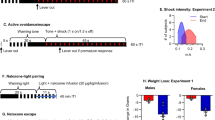Abstract
In Experiment I, two groups of rats were rewarded for lever-pressing under RI 64. During signalled 3-min intrusion periods shocks were delivered response-contingently (on RI 64) for the Punishment group and non-contingently (on RT 64) for the Conditioned Suppression group.d,l-Propranolol (2, 5 mg/kg) released intrusion responding to a similar extent in the two groups. Experiment II comprised two distinct experiments: two groups of rats were trained in parallel on signalled multiple schedules in which responding during the baseline component was rewarded on RI 20. For the second component responding was extinguished in Experiment IIa; it continued to be rewarded but was also punished by electric shock in Experiment IIb. Shock levels were adjusted individually so as to produce similar levels of response suppression in these two groups.d,l-Propranolol released non-rewarded responding (2–5 mg/kg; Expt IIa) but had no effect on punishment (2–10 mg/kg; Expt IIb).l-Propranolol (2.5 mg/kg) but notd-propranolol (2.5 mg/kg) also released non-rewarded responding in Expt IIa. In a further triald,l-propranolol (5 mg/kg) released punished responding in Expt IIb in a group of animals in which response suppression had been partially relieved by reducing shock intensity. It is hypothesized that beta-adrenergic stimuli may influence response suppression to the extent that the unconditioned aversive event causing suppression is not salient.
Similar content being viewed by others
References
Bainbridge JA, Greenwood DT (1971) Tranquillising effects of propranolol demonstrated in rats. Neuropharmacology 10:453–458
Barrett AM, Cullum VA (1968) The biological properties of the optical isomers of propranolol and their effects on cardiac arrhythmias. Br J Pharmacol 34:43–55
Bolles RC, Holtze R, Dunn T, Hill W (1980) Comparison of stimulus learning and response learning in a punishment situation. Learning and Motivation 11:78–96
Church RM, Wooten CL, Matthews TJ (1970) Discriminative punishment and the conditioned emotional response. Learning and Motivation 1:1–17
Conway J, Greenwood DT, Middlemiss DN (1978) Central nervous actions of β-adrenoceptor antagonists. Clin Sci Molec Med 54:1–8
Granville-Grossman KL, Turner P (1966) The effect of propranolol on anxiety. Lancet 1:788–790
Gray JA (1977) Drug effects on fear and frustration: In: Iversen L, Iversen S, Snyder S (eds) Handbook of psychopharmacology, vol 8, Plenum Press, New York, p 433
Gray JA (1982) The neuropsychology of anxiety. Oxford University Press, New York
Jefferson JW (1974) Beta-adrenergic blocking drugs in psychiatry. Arch Gen Psychiatry 31:681–691
Koella WP (1977) Anatomical, physiological and pharmacological findings relevant to the central nervous effects of the beta-blockers. In: Kielholz P (ed) Beta-blockers and the central nervous system. Hans Huber, Berne, p 21
Laverty R, Taylor KM (1968) Propranolol uptake into the central nervous system and the effect on rat behaviour and amine metabolism. J Pharm Pharmacol 20:605–609
McDevitt DG (1979) Adrenoceptor blocking drugs: clinical pharmacology and therapeutic use. Drugs 17:267–288
Middlemiss BN, Blakeborough L, Leather SR (1977) Direct evidence for an interaction of β-adrenergic blockers with the 5-HT receptor. Nature 267:289–290
Millenson JR (1975) System developments in the ACT language: towards machine independence. Behav Res Methods Instrumentation 7:165–173
Noyes R, Kathol R, Clancy J, Crowe RR (1981) Antianxiety effects of propranolol: a review of clinical studies. In: Klein DF, Rabkin J (eds) Anxiety: new research and changing concepts, Raven Press, New York, p 81
Rachman S, Hodgson R (1974) I. Synchrony and desynchrony in fear and avoidance. Behav Res Ther 12:311–318
Rawlins JNP, Feldon J, Salmon P, Gray JA, Garrud P (1980) The effects of chlordiazepoxide HCl administration upon punishment and conditioned suppression in the rat. Psychopharmacology 70:317–322
Redmond DE (1977) Alterations in the function of the nucleus locus coeruleus: a possible model for studies of anxiety. In: Usdin E, Hanin I (eds) Animal models in psychiatry and neurology. Pergamon Press, New York, p 293
Robichaud RC, Sledge KL, Hefner MA, Goldberg ME (1973) Propranolol and chlordiazepoxide on experimentally induced conflict and shuttle box performance in rodents. Psychopharmacology 32:157–160
Salmon P, Gray JA (1985a) Opposing acute and chronic behavioural effects of a beta-blocker, propranolol, in the rat. Psychopharmacology 86:480–486
Salmon P, Gray JA (1985b) Comparison between the effects of propranolol and chlordiazepoxide on timing behaviour in the rat. Psychopharmacology 87:219–224
Segal M, Bloom FE (1974) The action of norepinephrine in the rat hippocampus: II: activation of the input pathway. Brain Res 72:99–114
Sepinwall J, Grodsky FS, Sullivan JW, Cook L (1973) Effects of propranolol and chlordiazepoxide on conflict behavior in rats. Psychopharmacology 31:375–382
Tsaltas E, Gray JA, Fillenz M (1984) Alleviation of response suppression to conditioned aversive stimuli by lesions of the dorsal noradrenergic bundle. Behav Brain Res 13:115–128
Tyrer P (1976) The role of bodily feedlings in anxiety. Oxford University Press, London
Vaughan-Williams EM (1977) Adaptation of the heart and sympathetic system to prolonged β-adrenoceptor blockade. Proc R Soc Med 70: Suppl II, 49–59
Author information
Authors and Affiliations
Rights and permissions
About this article
Cite this article
Salmon, P., Gray, J.A. Effects of propranolol on conditioned suppression, discriminated punishment and discriminated non-reward in the rat. Psychopharmacologia 88, 252–257 (1986). https://doi.org/10.1007/BF00652250
Issue Date:
DOI: https://doi.org/10.1007/BF00652250




